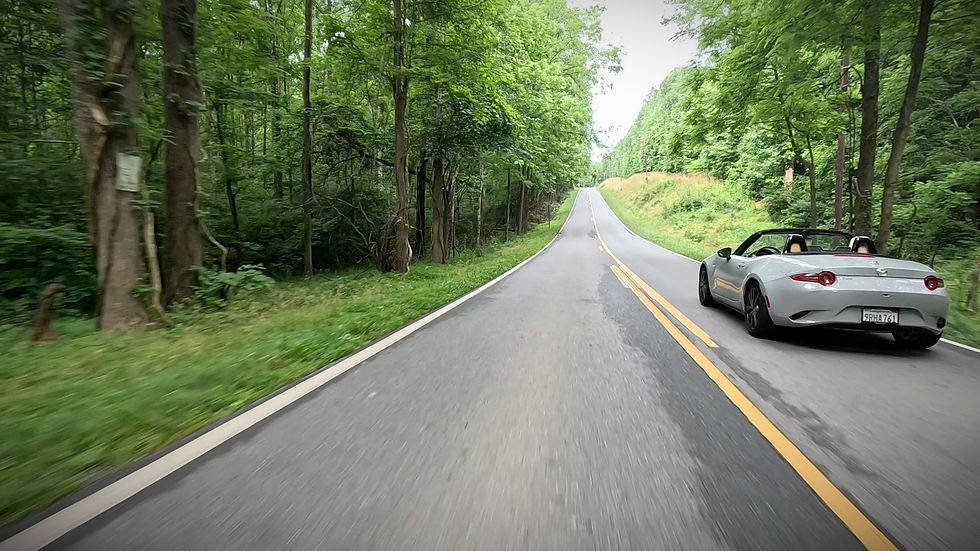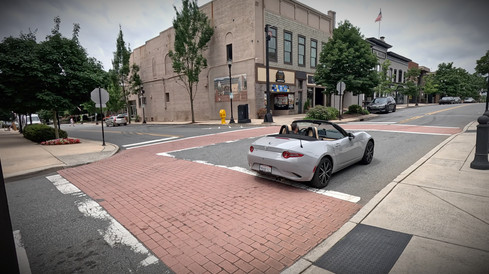Reviewed: The 2025 Mazda Miata Grand Touring – After 35 Years, is it Still the One?
- The Driver's Line

- Jul 1
- 8 min read
By Greg Karpinski
I confess, dear reader, that as someone who has already owned two Miatas in the 25 years I’ve been legally driving cars, this article will carry a certain bias. Ever since its inception in 1989 as a 1990 model, the Miata has been the best roadster money can buy, full stop. The original NA was a modern, reliable Lotus Elan, nimble, tossable and simple. The NB reached our shores in 1998 and added in some curves to the aesthetic, but the ethos remained. For 2006, the NC generation upped the both the performance envelope and everyday usability of the car, but the requisite growth was maligned by purists.

For the fourth generation, known as the ND, released in 2016, Mazda went back to basics, a focus on light weight and tidy proportions, but they got it a bit wrong to start. The chassis remained unmatched, but the 2.0L Skyactiv-G four-cylinder only put out 155hp and the manual gearboxes were made of glass. As someone who regularly competed in autocross at that time, I witnessed multiple ND gearboxes grenading on course. To their credit, Mazda largely covered these replacements, but the optics of a car known for weekend motorsport not living up to the task was bad. The ND2 revision in 2019 increased power to 181hp, raised the redline and solved the troublesome gearbox. For 2024, Mazda unveiled the ND3 revision, with minor aesthetic changes and developments to the suspension, steering rack and limited slip differential to further improve the drive. Is the third time the charm?
The Fine Print: All the “zoom-zoom” telepathy we sent Mazda’s way finally paid off, as they lent us The Answer for a week in the form a 2025 Miata Grand Touring. We took it on a run to Sam’s Club and Jordan walked back to headquarters.
Yes. And that’s not to say the earlier versions of the ND generation weren’t fabulous too, because they were, but with this third revision, Mazda got something that was already just right, somehow even more… right. Despite the internal bickerings of Miata owners, there is no objectively bad Miata.
Our 2025 Miata Grand Touring tester arrived finished in Aero Gray with a black cloth soft top and still looks fresh to our eyes. The appearance of the ND generation has evolved little from its debut nearly a decade ago in 2016 – the confused cat face remains, but the “whisker” DRLs now reside in the headlamp housings and out back the taillights have a more cohesive design with a vivid, three-dimensional appearance. Small cars don’t need big changes and Mazda was very thoughtful about any and all changes to their beloved roadster.
We only have a couple disappointments with the Miata’s design – first, and perhaps most importantly, why does Mazda only offer two actual colors on the Miata? It’s a travesty. This is a car with fun personality and it’s only offered in two greys, black, white, dark blue and one excellent red. There is precedent too – previous Miatas came in vibrant colors: Mariner Blue, Starlight Blue, Laguna Blue, Winning Blue, British Racing Green, Merlot, Sunburst Yellow, Velocity Red and Classic Red. The ND would look outstanding in every single one of them. The other disappointment is the integration of the back-up camera. Federal law mandated that all cars sold in the United States come with one after May 1, 2018 and Mazda complied in just about the laziest way possible – a small cutout smack dab in the middle of the rear fascia. Look, we don’t understand all the intricacy of requirements that may dictate camera height and location, but if we needed to mount it higher, why not integrate it with the Mazda badge on the decklid? If not, why not in the license plate housing like almost every other vehicle on the road? It’s unfortunate because now our eyes are always drawn to that little wart on the Miata’s otherwise shapely rear end.

Inside, the ND is objectively the nicest Miata ever. It represented a major departure from the plastic fantastic interiors of the NC, with Mazda focusing on design and high-quality materials, plus tastefully bringing in the exterior color onto the door cards in a way the PT Cruiser could only dream of. Drivers are faced with a clear set of analog gauges, with the tachometer front and center, as it should be in any sports car. A small multifunction screen is integrated into the gauge cluster and there is an 8.8-inch multimedia display with Android Auto and Apple CarPlay, wireless on the Club and Grand Touring.
Blessedly, there are actual buttons and knobs for functions that make sense, such as climate control, seat heating and drive modes. Our tester was equipped with Tan Nappa leather seats and, unless you want a Club with the Recaro seats, this is the way to go. When so-equipped, Mazda gives you excellent if slightly narrow seats, and brings the tan color onto the door cards and lower dashboard to break up what would otherwise be a sea of black. The result is an interior that looks and feels decidedly upscale.

Grand Touring trims come well-equipped with automatic climate control, automatic lighting, adaptive front lighting and high beam control, rain sensing wipers and an auto dimming side mirror, plus a nine- speaker Bose audio system with speakers built directly into the driver and passenger seat headrests. Audiophiles will probably be disappointed because they’re a particular lot, but it sounded good to our ears and allowed us to hear our tunes with the top down. The convertible top is another masterclass of engineering – Mazda first got it right with the Z-fold on the NC generation and that has carried forward to the ND – its manual operation can be completed with one hand and, when folded, looks like a fitted tonneau cover, resulting in a clean design when the top is down.
As a small car, Mazda was forced into several compromises, and they’re all the result of a lack of real estate. The interior of the Miata is tight and is likely out of bounds to anyone over six feet tall, as they will feel very shortchanged on knee and elbow room. There is no traditional glove box, just the storage bin between the seat-backs and zero fixed cupholders. Mazda has designed a modular cupholder that can be clipped in multiple locations, but it generally gets in the way more than is useful. While the four cubic feet of trunk space can manage to swallow up a couple soft-sided overnight bags, there isn’t room for much more. However, as has always been the ethos of the Miata, the focus is the drive, and that’s where this little roadster absolutely dances.

Pulling out onto the road, the latest Miata immediately conveys a sense of familiarity – it’s clear that the recipe hasn’t changed much over the years and the DNA Mazda so carefully cultivated in its best model remains fully intact here. Immediately, the light weight of the car becomes apparent – our Grand Touring tester tips the scales at just under 2400 pounds according to Mazda. That low weight allows the rest of the car to absolutely shine and also doesn’t require big numbers to deliver performance. Under the hood is the rev-happy 2.0L Skyactiv-G naturally-aspirated four-cylinder, that delivers 181hp and 151 lbft of torque and sings all the way to its 7,500 rpm redline. When equipped with the six-speed manual, which is the only way to have this car, the little Miata can sprint to 60 mph in 5.7 seconds and will trip the lights at the quarter mile in 14.4 seconds at 95 mph. The six-speed manual is an absolute joy – short, tight shifts with positive engagement every single time. That, coupled with a tight pedal box and ideal placement for heel toe action, makes shifting a pleasure rather than a chore, and encourages running up through the gears before blipping the throttle and downshifting as you apex a corner.
Where the Miata shines is in its balance – 53% of the weight sits above the front axle and 47% above the rear, close to that optimal 50/50 split. Grand Touring trims equipped with the manual gearbox come with sport-tuned dampers, courtesy of Bilstein and the ride is taut, yet comfortable, with the short wheelbase giving a bit of chop over imperfect surfaces. The beauty of this chassis is that, when pushed, it only encourages you to push it even further. The Miata relishes being grabbed by the scruff of its neck and flung into the next corner, the body rolling and the 205/45 17-inch Bridgestones hanging on for dear life. While Mazda could further stiffen the suspension and shove more rubber underneath the car, it’s not necessary and would lose the playful nature.

Despite the joyous simplicity, lurking underneath the surface of the Miata’s sheetmetal is a bit of
technical wizardry known as Kinematic Posture Control (KPC). Introduced in 2022, KPC acts similarly to torque vectoring, with the goal of enhancing handling and stability during high-g cornering. To achieve that, KPC will apply a slight brake force to the inside rear wheel during high-g cornering loads, which effectively both pulls down that corner of the car and helps it to rotate through the turn. The integration of KPC is so seamless that you honestly never feel it behind the wheel, but cars equipped with it have a subtle advantage in their eagerness to rotate while staying controlled. Two years later, Mazda introduced two additional innovations to the Miata – DSC Track mode and the Asymmetric Limited Slip Differential (LSD). DSC Track mode operates in the space between the DSC being fully enabled and completely off, allowing for a controlled oversteer and rotation before intervention. In spirited driving, we rarely felt it intervene. When it did, rear end rotation was progressive, so this would likely be ideal for HDPEs, but DSC fully off very likely still reigns supreme for autocross. The Asymmetric LSD introduced different locking rates for on and off power, but differentiating it from earlier NDs equipped with the previous LSD is hard to do. Ultimately, it handles just like a Miata should.

From a performance and handling standpoint, there isn’t much not to like here. The only gripe we have is that a sports car should sound like a sports car. The Miata is far too quiet, even when you’re flogging it and a Sport Exhaust option makes far too much sense to not include as an option from the factory. We’d love to see the return of a Suspension and Handling Package that reduces the body roll and ups the ante by putting a bit more rubber underneath the car – 17x8 BBS wheels with 225s would do nicely.
Over the years, rivals have come and gone, but the Miata has stood the test of time for 35 years because Mazda identified the right formula and then stuck with it. Other front-engine roadsters on the market today are few and far between, and significantly more costly – a base BMW Z4 certainly offers a bit more luxury, space and performance, but it also costs roughly twice as much as the base Miata. Most importantly, the fancier BMW isn’t better to drive. The Miata’s x-factor is that it’s impossible to not smile like an idiot when flogging this little car around your favorite backroad as the car dives and rollsthrough the twisties. And that’s why, at least in the affordable sports car space, Miata Is Always The Answer.






























Comments